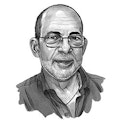I was searching the Internet for the earliest indications of figurative art—think: cave paintings—to help me with this column when I came across a 35,000-year-old image of a female pig dear that was found deep in a cave in Sulawesi, Indonesia. Alongside it was the outline of a hand—much like the outlines your preschooler might bring home—estimated to be almost 40,000 years old.
This discovery was important because it represented one of the earliest records of symbolism and imagination.
This is important for other reasons, as well, like our ancestor’s apparent need to share their experience. It was a way of proving they were here. Their way of leaving a tangible record.
If you think about it, we all want to leave some kind of tangible record we were here, whether through our children, our work, our institutions, or our art.
We are builders and need the world to see what we’ve built.
I’m not sure anyone has stated this more powerfully than Stephen R. Covey in First Things First, published in 1994.
Early in the book, Covey insists that we all have a deep, primordial need “to live, to love, to laugh, (and) to leave a legacy.” These were his “4 Ls,” and it would be hard to overemphasize their impact on my understanding of both our industry and the world in which I exist. Or, how it reinforced the importance of Abraham Maslow’s hierarchy of human needs, and the critical role it can play in understanding our industry, why we are where we are and our current reality.
This was clearly reflected in the margin notes I left in the book while trying to reconcile Maslow’s ladder with Covey’s “4 Ls.” Maslow’s hierarchy of human needs exists on five levels. The first and most basic is the satisfaction of physiological needs: the need to satisfy your hunger, your thirst, the need to be warm, the need to stay dry. The second rung is the need to feel secure. Maslow’s premise is simple: If you are starving, freezing or struggling with your physiological needs, the need for security is of no concern.
Maslow’s third rung is the need to belong: the need to be part of something larger, something greater than yourself. The fourth rung is the need to be esteemed. And, the fifth—and highest rung on the ladder—is self-actualization: the capacity to determine what you need, coupled with the ability to achieve whatever that might be.
I bracketed the first two rungs into Covey’s need to live. I bracketed belonging and esteem into Covey’s need to love. I decided our ability to laugh—at ourselves, as we move through the world—is transcendent: a critical human trait, without which life can become unbearable. And I decided the need to leave a legacy is a direct bi-product of self-actualization. That after figuring out what you both wanted and needed, and then achieving it, there was an almost irresistible need to memorialize and then share what you accomplished so that everyone else could see, hear and feel what you had accomplished.
I believe understanding Maslow’s ladder and Covey’s needs is critical to understanding our place in the world. And, I’ve worked hard to hit all four of Covey’s injunctions.
I’ve tried to live a full and positive life. I’ve loved. Not just my family, but my industry and the rich and rewarding relationships it has brought me. And, I’ve managed to develop an appreciation for beauty and art. And, I’ve laughed—hearty and often. But, realistically, I think I have been most effective in leaving a legacy of interesting stories, ideas, education, accountability, personal responsibility and philosophy.
It’s something I’ve been working on diligently for half a lifetime.
I’ve done this through my writing—almost 1,000 columns written to three different segments of our industry, crowned by an eight-volume set of management manuals. I’ve done it through the automotive shop management seminars I’ve created—and, presented—across the U.S. and Canada. And, the keynotes I’ve delivered at corporate and industry events.
Most recently, I’ve done it through the book I’ve just finished writing and editing. which I hope will serve as my true legacy.
Modestly, it represents my best work and offers the most I have ever been able to share in one place at one time. It is a business management allegory. A book about business written for folks who wouldn’t necessarily pick up and read a business management book. It’s a story that incorporates everything I know and I’ve learned, wrapped in an interesting and compelling story you will recognize much too easily.
The book, which is called Misfire: What to Do When Things Aren’t Running on All Cylinders, should be ready for release in print and as an e-book in the first quarter of 2019. And, I’m making it available to you before it is released to the general public because so many of you have been with me from the beginning. If you are interested in a pre-release copy, please don’t hesitate to reach out.
About the Author

Mitch Schneider
Mitch Schneider is a fourth-generation auto repair professional and the former owner of Schneider’s Auto Repair in Simi Valley, Calif. He is an industry educator, seminar facilitator, blogger, and author of the acclaimed novel Misfire.
